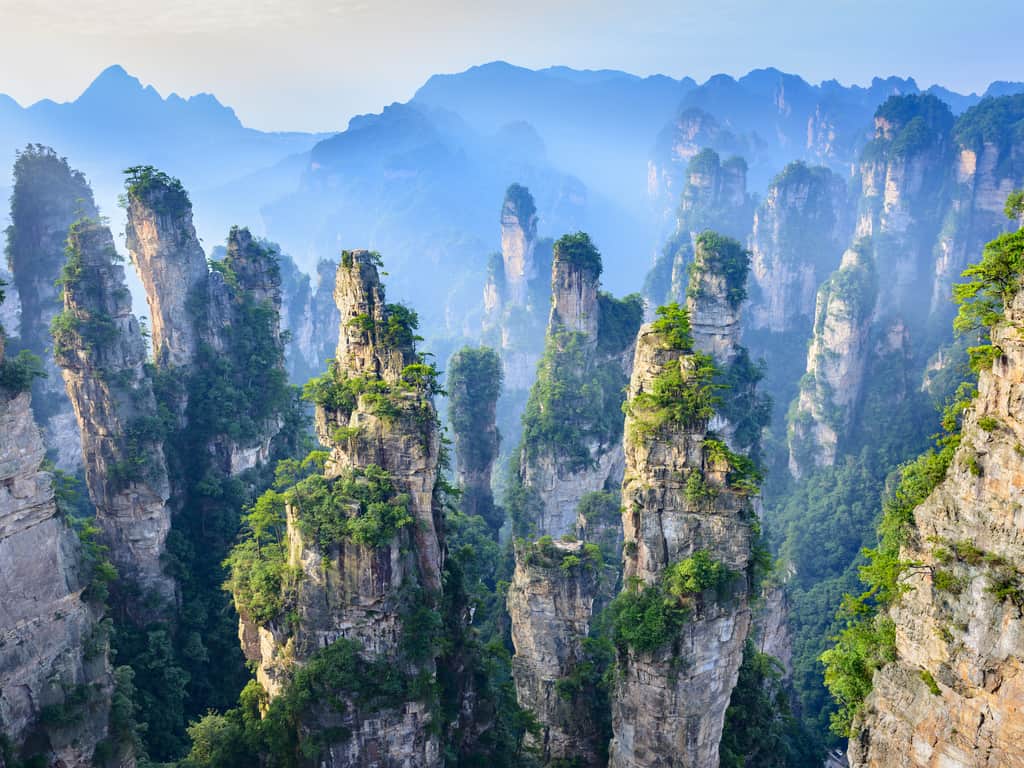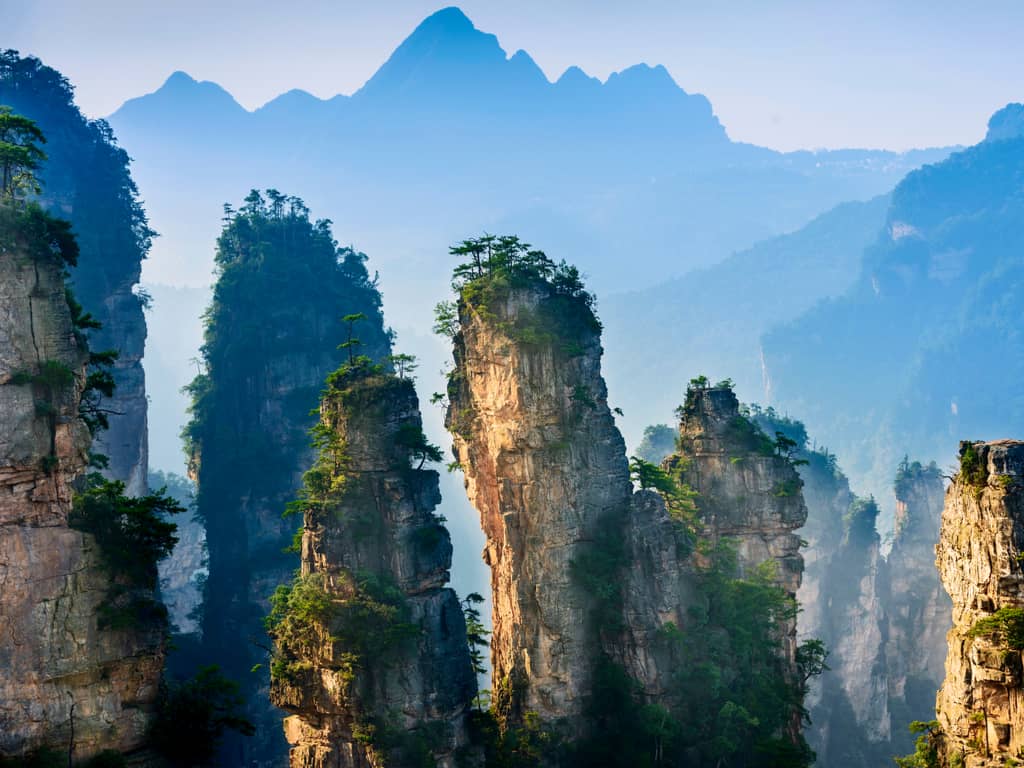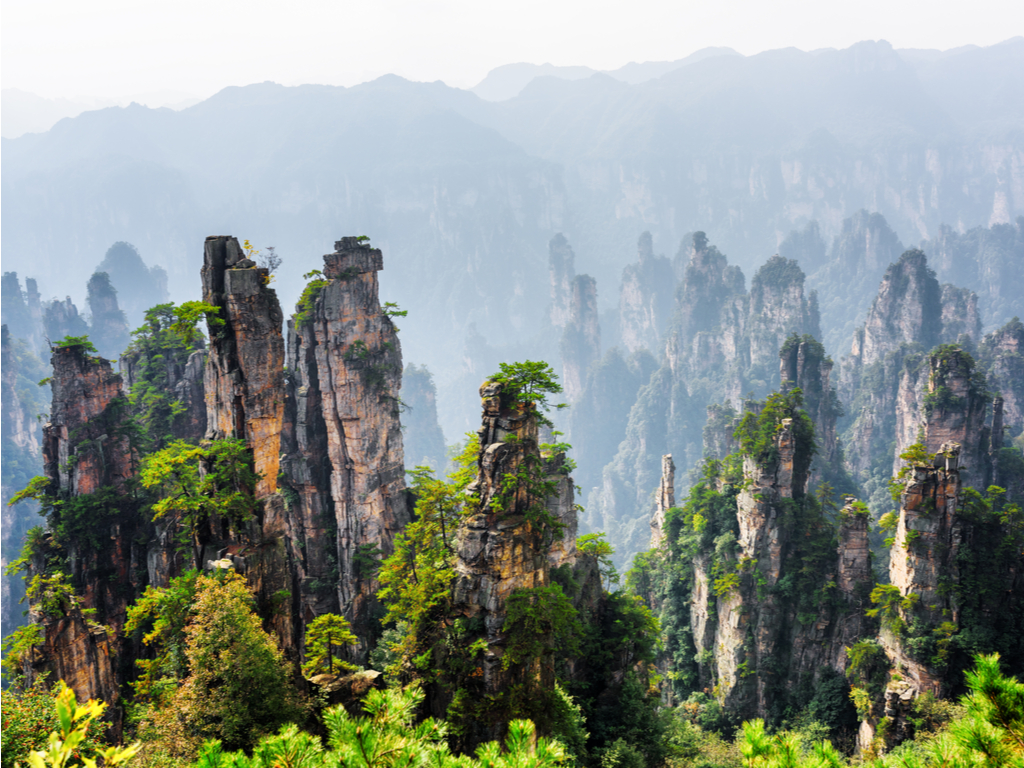The Tianzi Mountains in China’s Zhangjiajie National Forest Park and the surrounding Wulingyuan Scenic Area offer visitors a chance to experience some of the most stunning natural landscapes and cultural heritage in China. Whether you’re exploring the Avatar Mountains, hiking through the park’s lush forests, or taking in the breathtaking views from the glass bridge or cable cars, there is something for everyone in this incredible destination. With a little planning and preparation, you can make the most of your visit to Zhangjiajie National Forest Park and create memories that will last a lifetime.
If you’re fascinated by the natural scenery of the Avatar movie and also want to physically experience it, then you need to visit the Zhangjiajie mountains in China.
In this article, we will take you on a journey through the top things to see and do at Tianzi Mountains in China’s Zhangjiajie National Forest Park.

Contents
- 1 Exploring the Avatar Mountains: A Guide to Tianzi Mountains’ Iconic Peaks
- 2 Tips for Hiking in Zhangjiajie: What to Know Before You Go
- 3 A Guide to Tianzi Mountains Glass Bridge: The World’s Longest and Highest Glass-Bottomed Bridge
- 4 Discovering the Beauty of Tianmen Mountain: A Day Trip from Zhangjiajie
- 5 How to Avoid the Crowds in Zhangjiajie
- 6 Exploring Zhangjiajie’s Unique Flora and Fauna
- 7 Admiring the Stunning Landscapes of the Wulingyuan Scenic Area
- 8 Zhangjiajie’s Cable Cars: Which One to Take and What to Expect
- 9 What is Zhangjiajie famous for?
- 10 The Cultural Significance of Zhangjiajie and Its Place in Chinese History
- 11 How to get to Zhangjiajie in China
Exploring the Avatar Mountains: A Guide to Tianzi Mountains’ Iconic Peaks
The Tianzi Mountains are famous for their iconic peaks, which inspired the floating Hallelujah Mountains in the blockbuster movie Avatar. The most famous of these peaks is the pillar-like formation called the Southern Sky Column, which stands 1,080 meters tall. To get a bird’s-eye view of the Avatar Mountains, take a cable car up to the summit of Tianzi Mountain. From there, you can see panoramic views of the park’s peaks and valleys.
Another must-see peak is the Yuanjiajie Scenic Area, which is home to the Bailong Elevator, the world’s tallest outdoor elevator. The elevator takes visitors up 326 meters to a viewing platform at the top of a sheer cliff face. From there, you can take in stunning views of the surrounding peaks and forests.
Tips for Hiking in Zhangjiajie: What to Know Before You Go
Zhangjiajie National Forest Park is a hiker’s paradise, with trails that wind through some of the most stunning landscapes in the world. However, hiking in the park can be challenging, especially for those who are not used to steep inclines and rugged terrain. Here are some tips for hiking in Zhangjiajie:
- Wear comfortable, sturdy shoes with good traction.
- Dress in layers, as the weather can change quickly in the mountains.
- Bring plenty of water and snacks, as there are limited places to buy food and drinks in the park.
- Carry a map and a compass, as some of the trails can be confusing and poorly marked.
- Be prepared for steep inclines and narrow paths, especially in the more remote areas of the park.
A Guide to Tianzi Mountains Glass Bridge: The World’s Longest and Highest Glass-Bottomed Bridge
The Zhangjiajie Glass Bridge is a marvel of modern engineering, stretching 430 meters across a deep canyon and standing 300 meters above the ground. It is the world’s longest and highest glass-bottomed bridge, and offers visitors a heart-pumping experience unlike any other. Walking across the bridge can be terrifying, as the glass panels beneath your feet allow you to see all the way down to the canyon floor.
To avoid long lines and crowds, it is recommended that you book your visit in advance. Visitors are only allowed to cross the bridge in groups of 10, and tickets are limited. It is also important to note that the bridge can be closed in inclement weather, so be sure to check the forecast before you go.

Discovering the Beauty of Tianmen Mountain: A Day Trip from Zhangjiajie
Just a short distance from Zhangjiajie National Forest Park is Tianmen Mountain, another natural wonder that is not to be missed. The mountain is home to the Tianmen Cave, a natural arch that is 131 meters tall and 57 meters wide. To reach the cave, visitors must take a cable car up the mountain and climb 999 steps.
The mountain is also home to a glass walkway that extends out over the edge of a cliff, as well as a stunning waterfall and a temple that is built into the side of a cliff. There are plenty of hiking trails and scenic spots to explore, making Tianmen Mountain a great day trip from Zhangjiajie.
How to Avoid the Crowds in Zhangjiajie
Zhangjiajie National Forest Park is one of China’s top tourist destinations, so it can get quite crowded, especially during peak travel seasons. However, there are some off-the-beaten-path destinations within the park that are worth exploring, and can help you avoid the crowds. Here are a few options:
- Golden Whip Stream: This scenic area is located in the center of the park, and features crystal-clear waters, towering cliffs, and lush vegetation. The trail along the stream is a pleasant, leisurely walk that is suitable for all fitness levels. While it can still get busy, it is generally less crowded than some of the park’s more famous attractions.
- Huangshi Village: This area is located in the western part of the park, and offers stunning views of the surrounding peaks and valleys. The trail can be quite steep and strenuous in places, but the payoff is worth it. The area can get crowded during peak season, but it is generally less busy than the Avatar Mountains or the Glass Bridge.
- Baofeng Lake: This scenic lake is located in the southern part of the park, and can be reached by a short boat ride. The lake is surrounded by towering cliffs and dense forests, and is a peaceful, relaxing oasis in the midst of the park’s hustle and bustle.
Exploring Zhangjiajie’s Unique Flora and Fauna
Zhangjiajie National Forest Park is home to a rich array of flora and fauna, much of which is unique to the area. Some of the park’s most interesting plants include the Chinese yew, which is a slow-growing, long-lived tree that is used in traditional Chinese medicine, and the Chinese dove tree, which is known for its distinctive, fragrant flowers.
The park is also home to a wide range of animals, including macaques, civets, and many species of birds. The park’s most famous resident, however, is the rare and endangered South China tiger. While it is highly unlikely that you will see one of these elusive creatures during your visit, the park is working hard to protect and preserve the species.
Admiring the Stunning Landscapes of the Wulingyuan Scenic Area
Zhangjiajie National Forest Park is just one part of the larger Wulingyuan Scenic Area, which covers more than 26,000 hectares of stunning natural landscapes. In addition to the Avatar Mountains and other famous peaks, the area is home to dense forests, deep canyons, and rushing rivers.
One of the most popular ways to explore the Wulingyuan Scenic Area is by taking a leisurely boat ride down the Baofeng Lake. The lake is surrounded by towering cliffs and dense forests, and the boat ride is a peaceful, scenic way to take in the area’s beauty.

Zhangjiajie’s Cable Cars: Which One to Take and What to Expect
Zhangjiajie National Forest Park is home to a number of cable cars that can take visitors up to some of the park’s most stunning peaks and viewpoints. The cable cars are a convenient and efficient way to get around the park, but they can also be quite crowded during peak season. Here’s a rundown of some of the park’s cable cars:
Bailong Elevator: This is the world’s tallest outdoor elevator, and takes visitors up to the top of the Yuanjiajie Scenic Area. It can be quite crowded, but the views from the top are worth it.
Tianzi Mountain Cable Car: This cable car takes visitors up to the top of Tianzi Mountain, where you can see panoramic views of the Avatar Mountains and surrounding areas.
Huangshizhai Cable Car: This cable car takes visitors up to the Huangshizhai ScenicArea, which is located in the western part of the park. From the top, you can see sweeping views of the surrounding valleys and peaks.
Jinbian Cable Car: This cable car takes visitors up to the Jinbian Stream, which is a popular area for hiking and exploring. The cable car ride offers stunning views of the park’s rugged landscapes.
While the cable cars can be a bit pricey, they are generally a worthwhile investment, as they can save you time and energy in getting to some of the park’s more remote areas.
What is Zhangjiajie famous for?
Zhangjiajie is popular for its 3,000 rock pillars. These pillars are over 1,000 feet tall and densely covered with green foliage. They were formed naturally by erosion and now they bring in at least 30 million tourists each year.
Among these pillars, one was known as the “Southern Sky Column” and its height crossed 3,544 feet in the air, which is equal to 78 school buses in length.
In 2010 it was renamed “Avatar Hallelujah Mountain” – after the movie “Avatar”. The movie used pictures of the pinnacles and took inspiration for the floating mountain of Pandora.
The Cultural Significance of Zhangjiajie and Its Place in Chinese History
The Tianzi Mountains in China’s Zhangjiajie National Forest Park and the surrounding Wulingyuan Scenic Area have played an important role in Chinese history and culture for centuries. The area is home to several minority groups, including the Tujia, Miao, and Bai people, who have their own unique languages, traditions, and customs.
One of the most important cultural sites in the area is the Huangshi Village, which was once a strategic military outpost during the Ming Dynasty. The village is now a popular tourist destination, and offers stunning views of the surrounding peaks and valleys.
Another cultural highlight is the Zhangjiajie Grand Canyon Glass Bridge, which is designed to look like a traditional Chinese ink painting. The bridge is not only an engineering marvel, but also a nod to China’s rich artistic and cultural heritage.
In addition to its cultural significance, Zhangjiajie National Forest Park is also an important site for scientific research and preservation. The park is home to more than 3,000 plant species, as well as a wide range of animals, many of which are rare and endangered.

How to get to Zhangjiajie in China
Zhangjiajie can be accessed by either air or railroad. Other major tourist cities in China nearby are Guilin, Chengdu, Shanghai, and Beijing. However, the most convenient way to get to Zhangjiajie is by air.
Once you get to Zhangjiajie, there are several local means of transportation. Recommended are the buses from the city to the Wulingyuan Scenic Area and Zhangjiajie National Forest Park China.
Accessing Zhangjiajie by air
Zhangjiajie Hehua International Airport is located in Yongding District in Zhangjiajie. From there you will get direct flights to and Shenzhen, Guangzhou, Shanghai, Beijing, Changsha, and other important Chinese cities.
In case you are in any other Chinese city that doesn’t offer a direct flight to Zhangjiajie, you can take a connecting flight at Changsha, Guangzhou, or Shanghai.
Note that most flights to Zhangjiajie land in the evening. You can easily get city buses, airport shuttle buses, and taxis from the airport to various areas in Zhangjiajie city.
Accessing Zhangjiajie by railroad
Zhangjiajie Railway Station offers a well-structured rail network that directly links Zhangjiajie to most cities in China like Changsha, Guiyang, Shenzhen, Guangzhou, Shanghai, and Beijing.
The rail station is located 2km south of the center of the city and 1km away from the Tianmen Mountain cableway station.
One reason why getting to Zhangjiajie by railroad is not advisable is because the journey usually takes long hours. Nevertheless, if you’re traveling to Zhangjiajie from Guilin or Yichang, going by train can be the better option.
